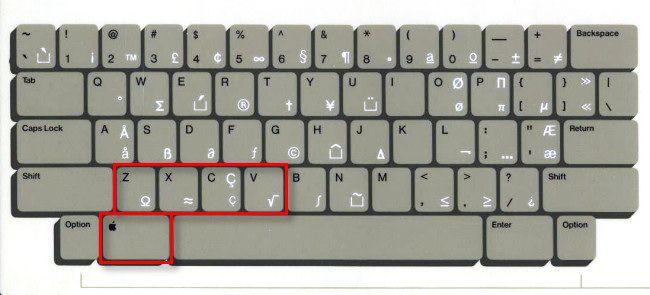注:机翻,未校对。
The Origins of Ctrl+C, Ctrl+V, Ctrl+X, and Ctrl+Z Explained

We use them dozens of times a day: The Ctrl+Z, Ctrl+X, Ctrl+C, and Ctrl+V shortcuts that trigger Undo, Cut, Copy, and Paste. But where did they come from, and why does Windows use those particular keys for those functions? We’ll explain.
我们每天使用它们数十次:触发撤消、剪切、复制和粘贴的 Ctrl+Z、Ctrl+X、Ctrl+C 和 Ctrl+V 快捷键。但是它们从何而来,为什么 Windows 使用这些特定键来实现这些功能?我们将解释的。
It Goes Way Back to Apple 它可以追溯到苹果
The story of Ctrl+Z, Ctrl+X, Ctrl+C, and Ctrl+V shortcuts for Undo, Cut, Copy, and Paste in Windows goes back to the very early 1980s. The earliest ancestor of these shortcuts appeared on the Apple Lisa computer in 1983. The Lisa was a precursor of the Macintosh and Apple’s first mouse-based computer.
在 Windows 中使用 Ctrl+Z、Ctrl+X、Ctrl+C 和 Ctrl+V 快捷键进行撤销、剪切、复制和粘贴的故事可以追溯到 1980 年代初期。这些快捷键的最早祖先出现在 1983 年的 Apple Lisa 计算机上。Lisa 是 Macintosh 的前身,也是苹果首款基于鼠标的计算机。
 Apple
Apple
While developing the user interface for the Lisa, Apple programmer Larry Tesler chose to use the Z, X, C, and V keys in conjunction with the Lisa’s Apple key to represent Undo, Cut, Copy, and Paste. Together, they made Apple+Z, Apple+X, Apple+C, and Apple+V. In a circa-2016 email to Dr. Brad A. Myers of Carnegie Mellon University, Tesler described exactly why he chose those specific letters:
在为 Lisa 开发用户界面时,Apple 程序员 Larry Tesler 选择将 Z、X、C 和 V 键与 Lisa 的 Apple 键结合使用,以表示撤消、剪切、复制和粘贴。他们一起制作了 Apple+Z、Apple+X、Apple+C 和 Apple+V。在大约2016年给卡内基梅隆大学(Carnegie Mellon University)的布拉德·迈尔斯(Brad A. Myers)博士的一封电子邮件中,特斯勒准确地描述了他选择这些特定字母的原因:
The Lisa was the first system to assign XCVZ to cut, copy, paste and undo (shifted with the “apple” key). I chose them myself. X was a standard symbol of deletion. C was the first letter of Copy. V was an upside down caret and apparently meant Insert in at least one earlier editor.
Lisa 是第一个分配 XCVZ 剪切、复制、粘贴和撤消(使用“apple”键移动)的系统。我自己选择了它们。X 是删除的标准符号。C 是 Copy 的第一个字母,V 是一个倒置的插入符号,显然意味着至少一个早期编辑器中的插入符号。
Z was next to X, C and V on the U.S. QWERTY keyboard. But its shape also symbolized the “Do-Undo-Redo” triad: top rightward stroke = step forward; middle leftward stroke = step back; bottom rightward stroke = step forward again.
Z 键在美式 QWERTY 键盘上位于 X、C 和 V 旁边。但是,它的形状也象征着“做-撤销-重做”的三位一体:顶部右向笔划=向前一步;中部左向笔划=退回一步;底部右向笔划=再次向前一步。
Tesler also notes that the Apple+Z key originally served as both an Undo and a Redo key—instead of the multi-step Undo we now know today (with Ctrl+Y usually being Redo on Windows), which makes his symbolic explanation of the letter “Z” for Undo make more sense.
Tesler 还指出,Apple+Z 键最初既是撤消键又是重做键—而不是我们今天所知道的多步骤撤消键(Ctrl+Y 通常在 Windows 上是重做),这使得他对字母“Z”的象征性解释更有意义撤消。
 Apple
Apple
Obviously, these keys are also handy in that they are located in the lower-left corner of the keyboard near meta keys such as Apple (on the Lisa), Command (on the Mac), and Control (on PCs). So if you’re using a computer’s mouse with your right hand, you can quickly trigger these frequently-used functions with your left hand.
显然,这些键也很方便,因为它们位于键盘左下角的元键附近,例如 Apple(在 Lisa 上)、Command(在 Mac 上)和 Control(在 PC 上)。因此,如果您用右手使用计算机鼠标,则可以用左手快速触发这些常用功能。
When Apple developed the Macintosh, it brought forward the Lisa’s Z/X/C/V keyboard shortcuts but adapted them for the Command key that was unique to the Mac platform. So on a Mac in 1984, as with today, you’d press Command+Z for Undo, Command+X for Cut, Command+C for Copy, and Command+V for paste.
当苹果公司开发 Macintosh 时,它延续了 Lisa 的 Z/X/C/V 键盘快捷键,但将其调整为适用于 Mac 平台独有的 Command 键。因此,在 1984 年的 Mac 上,就像今天一样,你需要按 Command+Z 来执行撤销操作,按 Command+X 来剪切,按 Command+C 来复制,以及按 Command+V 来粘贴。
It’s worth noting that while the Apple Lisa introduced the Z/X/C/V shortcuts, the actual concepts for Undo, Cut, Copy and Paste originated earlier with interfaces for software developed for the Xerox Alto in the 1970s.
值得注意的是,虽然 Apple Lisa 引入了 Z/X/C/V 快捷方式,但撤消、剪切、复制和粘贴的实际概念起源于 1970 年代为 Xerox Alto 开发的软件接口。
The Shortcuts Come to Windows 快捷方式来到 Windows
At the dawn of the Graphical User Interface (GUI) era for Microsoft, Apple licensed some elements of the Macintosh OS to Microsoft for Windows 1.0, but Redmond took care to not exactly duplicate the Macintosh interface. It’s probably no surprise then that between Windows 1.0 and Windows 3.0, Microsoft originally assigned different shortcuts for Undo, Cut, Copy and Paste than the ones most people use today:
在 Microsoft 图形用户界面(GUI)时代的曙光中,Apple 将 Macintosh OS 的一些元素授权给 Microsoft 用于 Windows 1.0,但 Redmond 注意不要完全复制 Macintosh 界面。因此,在 Windows 1.0 和 Windows 3.0 之间,Microsoft 最初为撤消,剪切,复制和粘贴分配了与今天大多数人使用的快捷方式不同的快捷方式,这可能不足为奇:
- Undo: Alt+Backspace 撤消
- Cut: Shift+Delete 剪切
- Copy: Ctrl+Insert 复制
- Paste: Shift+Insert 粘贴
Windows still supports these legacy shortcuts (and some people still love using them). At some point during the development of Windows 3.1, Microsoft brought Ctrl+Z, Ctrl+X, Ctrl+C, and Ctrl+V to Windows as well. They had already appeared Word for Windows 2.0 in 1991, and possibly other Windows Office apps.
Windows 仍然支持这些传统的快捷键(有些人仍然喜欢使用它们)。在 Windows 3.1 开发过程中的某个时刻,微软也将 Ctrl+Z、Ctrl+X、Ctrl+C 和 Ctrl+V 引入了 Windows。它们已经出现在 1991 年的 Word for Windows 2.0 中,可能也出现在其他 Windows Office 应用程序中。
We asked former Microsoft VP Brad Silverberg the reason for including these new shortcuts in Windows 3.1, and he recalls that the Windows team might have been trying to be consistent with Office apps, some of which originated on the Macintosh. They were also more user-friendly: “I liked ZXVC better—easier to remember, and it seemed like a good idea,” says Silverberg.
我们询问了前Microsoft副总裁布拉德·西尔弗伯格(Brad Silverberg)在Windows 3.1中包含这些新快捷方式的原因,他回忆说,Windows团队可能一直在尝试与Office应用程序保持一致,其中一些应用程序起源于Macintosh。它们也更加人性化:“我更喜欢 ZXVC—更容易记住,这似乎是个好主意,”Silverberg 说。
我们问过前 Microsoft 副总裁布拉德·西尔弗伯格(Brad Silverberg)为什么在 Windows 3.1 中包含这些新的快捷键,他回忆道,Windows 团队可能试图与部分起源于 Macintosh 的 Office 应用程序保持一致。这些快捷键也更加人性化:“我更喜欢 ZXVC—更容易记住,这似乎是个好主意,”Silverberg 说。
PC Magazine noticed the new shortcuts in its 1992 review of Windows 3.1 and called the decision “one of the more controversial changes made in this upgrade.” But from what we can tell, there was never any kind of mass protest over adopting these shortcuts into Windows. “I don’t think they were all that controversial and were adopted very quickly,” recalls Silverberg.
PC Magazine 在 1992 年对 Windows 3.1 的评论中注意到了新的快捷方式,并称该决定是 “此次升级中最具争议的更改之一”。但据我们所知,在 Windows 中采用这些快捷方式从未发生过任何形式的大规模抗议。“我不认为它们有那么大的争议性,而且很快就被采用,” 西尔弗伯格回忆道。
It all worked out well in the end. Since 1992, every desktop version of Windows has included the Ctrl+Z, Ctrl+X, Ctrl+C, and Ctrl+V shortcuts for Undo, Cut, Copy, and Paste. It’s a legacy that goes all the way back to 1983. Happy editing!
最后一切都很顺利。自 1992 年以来,每个桌面版本的 Windows 都包含用于撤消、剪切、复制和粘贴的 Ctrl+Z、Ctrl+X、Ctrl+C 和 Ctrl+V 快捷方式。这一传统可以追溯到 1983 年。祝您编辑愉快!
via:
- The Origins of Ctrl+C, Ctrl+V, Ctrl+X, and Ctrl+Z Explained By Benj Edwards Updated May 23, 2022





















 1610
1610

 被折叠的 条评论
为什么被折叠?
被折叠的 条评论
为什么被折叠?








